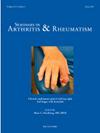雷诺氏现象与心血管疾病和静脉血栓栓塞的风险增加有关
IF 4.4
2区 医学
Q1 RHEUMATOLOGY
引用次数: 0
摘要
目的雷诺氏病(RP)是一种常见病,影响人口的3 - 5%;然而,关于血管预后的数据很少。我们的目的是评估无相关系统性自身免疫性风湿病(SARDs)的RP患者心血管疾病(CVD)和静脉血栓栓塞(VTE)的风险。方法采用来自北美电子医疗机构记录的数据进行队列研究。RP的定义采用≥2个ICD编码(I73.0),不包括伴有SARDs的患者。比较者有≥2个肠易激综合征(IBS) ICD编码(K58);被选为具有相似人口统计学特征但通常不与不良心血管疾病结果相关的疾病。队列按年龄(45岁和≥45岁)分层。共同主要结局是1)主要不良心血管事件(MACE)和2)静脉血栓栓塞(VTE)。次要结局包括:心肌梗死、中风、任何心血管疾病。采用1:1倾向评分匹配的Cox比例风险模型比较各结局的风险。结果30,088对年龄45岁的配对患者中,MACE (HR 1.23[1.07, 1.42])和VTE (HR 1.32[1.20, 1.46])的RP(不包括SARD)风险比(HR [95% CI])高于IBS(不包括SARD)。同样,在60145对年龄≥45岁的配对中,MACE (HR 1.17[1.13, 1.22])和VTE (HR 1.20[1.14, 1.26])在RP中较高。RP组继发性结局的风险更高,尽管对45岁以下患者的深静脉血栓和心肌梗死的两项分析的估计缺乏准确性。结论srp与CVD和VTE风险增加相关,与年龄和传统心血管危险因素无关。未来的研究需要进一步证实,探索病理生物学机制,并制定治疗策略。本文章由计算机程序翻译,如有差异,请以英文原文为准。
Raynaud’s phenomenon is associated with an increased risk of cardiovascular disease and venous thromboembolism
Objectives
Raynaud’s phenomenon (RP) is common affecting 3–5 % of the population; however, there are little data concerning vascular outcomes. We aimed to estimate risk of cardiovascular disease (CVD) and venous thromboembolism (VTE) in individuals with RP without underlying relevant systemic autoimmune rheumatic diseases (SARDs).
Methods
A cohort study using data from North American electronic healthcare organization records. RP was defined using ≥2 ICD codes (I73.0), excluding those with SARDs. Comparators had ≥2 irritable bowel syndrome (IBS) ICD codes (K58); selected as a condition with similar demographics but not typically associated with adverse CVD outcomes. Cohorts were stratified by age (<45 and ≥45 years). Co-primary outcomes were 1) major adverse cardiovascular events (MACE), and 2) VTE. Secondary outcomes included: myocardial infarction, stroke, any CVD. Risk of each outcome was compared using 1:1 propensity score matched Cox proportional hazard models.
Results
Among 30,088 matched pairs aged <45, hazard ratios (HR [95 % CI]) of MACE (HR 1.23 [1.07, 1.42]) and VTE (HR 1.32 [1.20, 1.46]) were higher in RP (excluding SARD) than IBS. Similarly, in 60,145 matched pairs ages ≥45, MACE (HR 1.17 [1.13, 1.22]) and VTE (HR 1.20 [1.14, 1.26]) were higher in RP. Risk of secondary outcomes was higher in RP, although estimates for DVT in both analyses and myocardial infarction in patients under 45 lacked precision.
Conclusions
RP was associated with an increased risk of CVD and VTE, independent of age and traditional cardiovascular risk factors. Future research is warranted to confirm, explore pathobiological mechanisms, and develop therapeutic strategies.
求助全文
通过发布文献求助,成功后即可免费获取论文全文。
去求助
来源期刊
CiteScore
9.20
自引率
4.00%
发文量
176
审稿时长
46 days
期刊介绍:
Seminars in Arthritis and Rheumatism provides access to the highest-quality clinical, therapeutic and translational research about arthritis, rheumatology and musculoskeletal disorders that affect the joints and connective tissue. Each bimonthly issue includes articles giving you the latest diagnostic criteria, consensus statements, systematic reviews and meta-analyses as well as clinical and translational research studies. Read this journal for the latest groundbreaking research and to gain insights from scientists and clinicians on the management and treatment of musculoskeletal and autoimmune rheumatologic diseases. The journal is of interest to rheumatologists, orthopedic surgeons, internal medicine physicians, immunologists and specialists in bone and mineral metabolism.

 求助内容:
求助内容: 应助结果提醒方式:
应助结果提醒方式:


